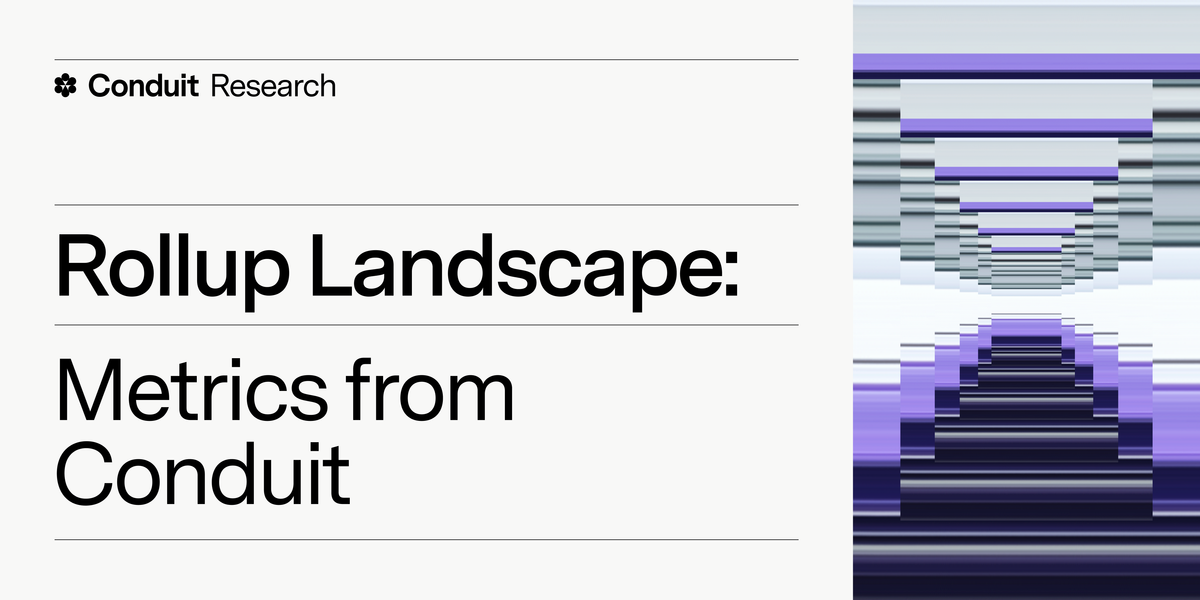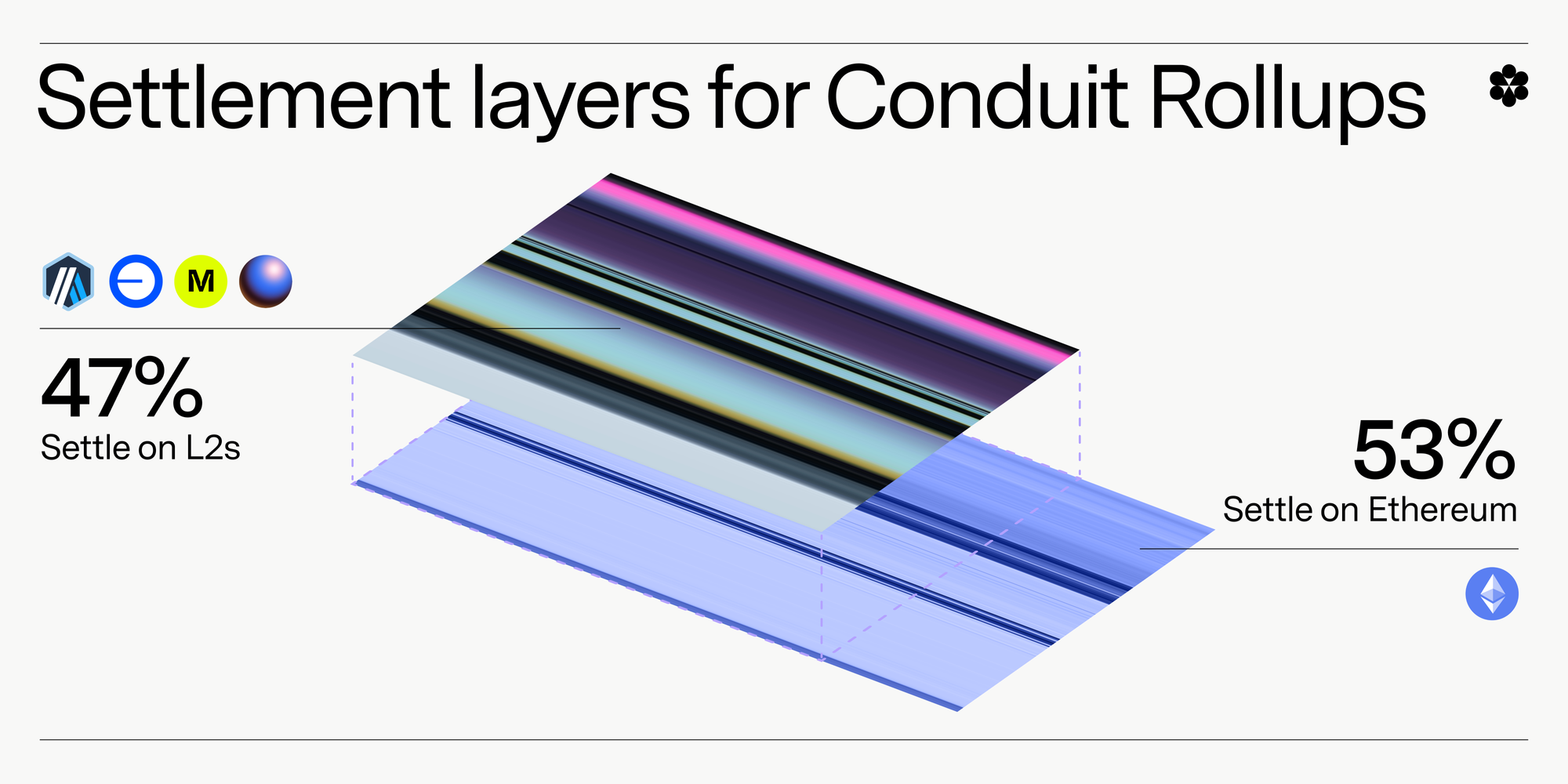The Rollup Landscape: Metrics on Rollup Frameworks, Data Availability, Settlement Layer, and More
Metrics from Conduit rollups on the most common rollup frameworks, data availability providers, settlement layers, and more.

Conduit is crypto’s biggest rollup platform, powering hundreds of chains in categories like gaming, DEXs, ecosystems, and more. Overall, we support more than 300 rollups across mainnet and testnet. Mainnet rollups running on Conduit hold a total of $1.2 billion in TVL, and account for:
- 55% of all hosted mainnets
- 70% of all hosted mainnet transaction activity
- 52% of total computing power across all rollups — hosted or self-built — and Ethereum mainnet itself, as measured in gas usage

Rollups choose Conduit because our platform is the easiest way to customize, deploy, and scale a rollup. We have the tools you need to achieve the highest possible onchain performance, including the world’s most powerful sequencer, Conduit-exclusive enhancements to data availability (DA) providers like Celestia and EigenDA, and fast finality via OP Succinct.
Our position as the leading rollup platform also gives us a unique view into the rollup landscape, allowing us to act as a bellwether on overall trends. Below, we’re going to share the latest metrics on how rollups are being built, using data from the Conduit platform.
Rollup frameworks
One of the first and most important questions rollup builders have to answer is which framework they’ll use. OP Stack rollups can benefit from the Superchain community and eventual interoperability, while Arbitrum Orbit rollups can tap into shorter default block times, fast withdrawals, and tools like Stylus.
Which do Conduit rollups prefer? The data shows a nearly even split, with OP Stack rollups in front at 56% of mainnets on our platform.

Data availability
DA is another important component of the rollup stack. Ever since Ethereum blobs became available in March 2024, DA costs have plummeted, allowing compute-intensive rollup use cases to flourish. However, alt DA providers have made even bigger gains in throughput and efficiency, driving DA costs even lower. But how widely adopted are these providers?
Very widely. On the Conduit platform, 76% of active mainnets use an alt DA provider, while the remaining 24% use Ethereum blobs.

Conduit rollups are especially primed to take advantage of alt DA, as we work with providers to create better, higher-throughput DA options for the chains we power, such as Celestia SuperBlobs and EigenDA 16mb blobs.
Recently, blobs have hit price discovery and become more expensive as blobspace is getting scarcer. If this continues, we’d expect even more rollups to embrace cheaper alt DA options, though these can in some cases hinder rollups’ ability to take advantage of framework upgrades and integrate other functionalities.
Settlement layer
Choosing the right settlement layer is also important for rollups. Most rollups operate as L2s, meaning they are built on top of Ethereum mainnet and ultimately commit their transaction history to Ethereum for finality. However, in the last few months, we’ve seen many new L3s, meaning chains built on top of L2s – most commonly Base or Arbitrum One. Proof of Play is a perfect example, as it operates two ultra high-performance L3s on Arbitrum One to support its fully onchain game Pirate Nation.
L3s are more popular than many realize, as they are typically cheaper to operate and allow new chains to tap into the user bases of more established L2s. In fact, when it comes to rollups on Conduit, L2s and L3s are nearly even.

L3s represent 47% of active mainnets on Conduit, and as the Proof of Play example would suggest, are especially popular for gaming rollups.
Custom gas token
Finally, many rollups also opt to use a custom gas token rather than the default option of ETH. ETH is convenient as a gas token because most users already hold it, and it’s helpful for sequencers to receive a steady supply via gas fees, as they must pay DA costs in ETH.
However, with DA getting cheaper, it’s become more feasible for rollups to use a custom gas token and take the risk of losing money on swaps between their token and ETH. There are several reasons a custom gas token can be beneficial for a rollup, such as improved tokenomics and the ability to implement unique chain permissioning functionalities.
So far, custom gas tokens are still less widely used for Conduit rollups than ETH, at just 34% of tokens.

However, if alt DA adoption continues to rise and prices stay low, we may see more chains move to a custom gas token in the near future.
What’s next for rollups?
Rollups are an emerging technology, with new innovations happening all the time. At this time last year, for instance, Ethereum blobs didn’t even exist and alt DA was just getting off the ground. The breakdown of rollup tech stacks could be completely different months from now, not to mention the possible emergence of new infrastructure categories that don’t yet exist. We look forward to guiding our customers through these changes to help them maximize their chains’ performance.

